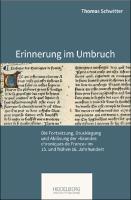Erinnerung im Umbruch
Single-Blind-Peer-Review overseen by Series Editor
Die Fortsetzung, Drucklegung und Ablösung der »Grandes chroniques de France« im 15. und frühen 16. Jahrhundert
Author(s)
Schwitter, Thomas
Collection
AG UniversitätsverlageLanguage
GermanAbstract
The study traces the development of historiography surrounding the rulers in France in the 15th and early 16th centuries. In the first two parts, the focus is on the continuation and printing of the “Grandes Chroniques” in the 15th century up to the replacement of this leading text by the new, humanistically influenced works of Robert Gaguin and Paulus Aemilius. Along the way, numerous stages of development are reconstructed. Moreover, many historiographical works that have hardly been studied so far but were influenced heavily by the “Grandes Chroniques” are also discussed. For a long time during that period, the main topic of French historiography was the French Civil War (1407–1435) and the associated conflict with the English kings. The struggle of various parties for interpretative sovereignty over those decades therefore had a decisive influence on the development of French historiography in the 15th and early 16th centuries, which will be examined in the third part. Die Studie zeichnet die Entwicklung der herrschaftsnahen Historiografie Frankreichs im 15. und frühen 16. Jahrhundert nach. Im Fokus steht dabei in den zwei ersten Teilen die Fortsetzung und Drucklegungen der »Grandes Chroniques« im 15. Jahrhundert bis hin zur Ablösung dieses Leittextes durch die neuen, humanistisch geprägten Werke von Robert Gaguin und Paulus Aemilius. Dazwischen werden zahlreiche Entwicklungsstufen rekonstruiert und auch bislang kaum untersuchte Werke thematisiert. Das Hauptthema der französischen Historiografie war in jener Zeit lange die damals jüngere Vergangenheit, das heißt der französische Bürgerkrieg (1407–1435) und der damit verbundene Konflikt mit den englischen Königen. Das Ringen verschiedener Parteien um die Deutungshoheit über jene Jahrzehnte prägte deshalb die Entwicklung der französischen Historiografie im 15. und frühen 16. Jahrhundert maßgeblich, was im dritten Teil der Arbeit untersucht wird. À partir du xiiie siècle, les »Grandes chroniques de France«, pièce maîtresse de l’historiographie française, furent régulièrement augmentées et mises à jour. Au xve et au début du xvie siècle, le thème central de cette historiographie proche du pouvoir était la guerre civile entre Armagnacs et Bourguignons (1407–1435), et la guerre de Cent Ans, qui y était associée. Le développement historiographique était étroitement lié à la lutte de différentes parties pour la souveraineté de l’interprétation de ces conflits. Cette revendication est analysée ici pour la première fois dans un contexte où les »Grandes chroniques« ont, certes, été continuées en tant que récit historiographique, mais dans lequel, en même temps, de nouvelles œuvres d’inspiration humaniste les ont progressivement remplacées. L’étude reconstruit de nombreuses étapes de l’évolution des »Grandes chroniques« et traite également de textes créés dans leur environnement et qui n’ont guère été étudiés jusqu’à présent. Pour ce faire, manuscrits et ouvrages imprimés sont pris en compte de la même manière.


 Download
Download Web Shop
Web Shop